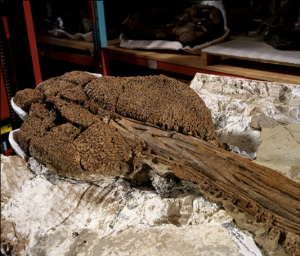Named after Zuul from Ghostbusters, this ankylosaurid grew spines from its flesh.

The creature is the most complete ankylosaurid—a type of club-tailed armored dinosaur—ever found in North America. It’s also amazingly preserved. Zuul’s armor fossilized in place, down to the furrowed soft tissues sheathing it. Preserved damage on Zuul’s flank may even chronicle its battles with other ankylosaurids. “It’s beyond our wildest dreams,” says David Evans, the Royal Ontario Museum paleontologist who is leading the study of Zuul.

The armored beasts of the Cretaceous known as ankylosaurine dinosaurs don’t get as much love as the charismatic T. rex. But now, one of the world’s only complete ankylosaurid skeletons has been acquired and analyzed by the Royal Ontario Museum—and the artifact even has a significant amount of mummified tissues like skin. At this point, there’s no denying that this creature, whose body was covered in spikes, horns, and scales like a medieval dragon, has earned the wholly scientific designation of “badass.”

In a paper for the Royal Society Open Science, Royal Ontario Museum paleontologists Victoria Arbour and David Evans describe the 75 million-year-old creature, a new species they dubbed Zuul crurivastator. Yes, its name is a reference to the demon Zuul from the original Ghostbusters movie. “Crurivastator” means “crusher of shins,” which is exactly what this creature could do with its spiked, hammer-tipped tail.
Weighing 2.5 tonnes and spanning 20 feet from its horned face to its spiny tail, Zuul was a living tank. In previous work, Arbour demonstrated using computer models that a beast like Zuul could use its tail club to break leg bones in its foes. This would have been especially effective against predator T. rex, which walked on two legs. Take out one leg, and the animal won’t survive long in the dinosaur-infested jungles of the Cretaceous.
One of the most exciting things about this find is how much of Zuul’s soft tissues were preserved, giving scientists a unique opportunity to see the texture of its skin imprinted on the rock that encased it. Zuul’s spikes and scales were embedded in its skin, so now we have a very clear picture of just how dragon-like this animal appeared. Spines protruded from its body, much like the sharp plates that run down Godzilla’s spine.

Arbour and Evans will also be able to run chemical analyses on the mummified skin, searching for proteins that will hint at Zuul’s molecular biology. Writing on the Royal Museum of Ontario website, the researchers map out their next moves:
The incredible preservation of Zuul’s skeleton gives us the opportunity to use cutting-edge molecular palaeontology techniques to search for original proteins and other organic biomolecules in the soft tissue. We’ll also be using radiometric dating analyses to study the age of Zuul and the surrounding rocks, and will describe the other plants and animals from the quarry that lived in the same ecosystem as Zuul.
Zuul was found, appropriately, in the northern Montana Badlands just 25 km from the Alberta border. Researchers from the Southern Alberta Dinosaur Project had been digging for T. rex remains when they bumped into Zuul and discovered that its remains were miraculously intact. Its skull was slightly deformed in the millions of years it spent under heavy rocks, but researchers have reconstructed what the skull might have looked like at the moment of death (see video above).

The dry environment had mummified parts of Zuul during the fossilization process, allowing scientists to see one of these deadly fighters in its full glory. All hail Zuul, crusher of shins and defender against the mighty T. rex!

The tanklike herbivore died 76 million years ago in what’s now northern Montana, near an estuary fringing an ancient sea. Its bloated carcass somehow ended up in a river, where it got caught in a logjam and was quickly buried in sand. The animal stayed entombed until 2014, when private fossil excavators stumbled across the remains. The Royal Ontario Museum acquired the fossil in 2016, and in May 2017, museum researchers declared it a new type of dinosaur. While research on the fossil continues, Zuul has made its red-carpet premiere—as the focus of a new museum exhibit.